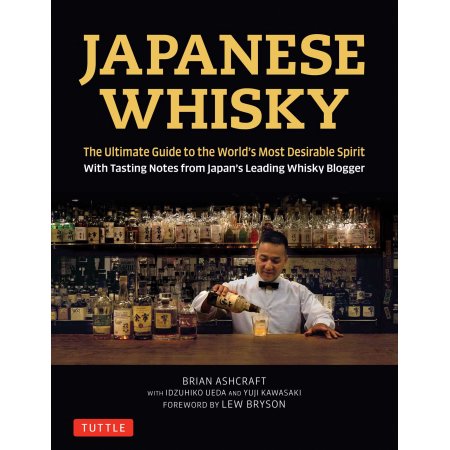Book Review: Japanese Whisky The Ultimate Guide to the World's Most Desirable Spirit by Brian Ashcraft
"For relaxing times, make it Suntory time." 13 years after Lost in Translation's release, it seems as though the whole world has caught on and made their relaxing time a Suntory one, or Nikka...or any other Japanese whisky brand in fact, judging by how the industry is making international headlines every month. For the last three to four years, Japanese whisky sales has shot through the roof both domestically and internationally, winning numerous accolades and garnering immense praise from both critics and consumers alike. However, the attention has been a double-edged sword, with newer boys in the business being forced to innovate with non-age statement expressions or to bide their time and hope that the world is still as receptive in a few years. For market leaders Suntory and Nikka, they must be kicking themselves for not having the foresight to predict the success they're having currently, having opted to play it safe when the industry was in a lull. For the former brand, it has had to cease distribution for its popular Hakushuu 12 and Hibiki 17 expressions. On Nikka's end, they've had to do the same for their Yoichi and Miyagikyo lines. And as for myself, I regret not buying a few bottles when I had the chance to while I was travelling..and for finishing my bottle of Yamazaki 12 a little too quickly. Oh well, they say that hindsight is 20/20 after all.
With all the buzz surrounding Japanese whisky recently, I was curious to find out what made their take on the caramel-coloured spirit so appealing to consumers worldwide in recent years, even beating out bigwigs from Scotland and the USA. Enter Brian Ashcraft's Japanese Whisky: The Ultimate Guide to the World's Most Desirable Spirit. I came across the book while window shopping recently and eventually bought it after my browsing session threatened to become an in-depth reading. The book is split into two parts, with the first one detailing the history of Japanese whisky and what makes the tipple uniquely Japanese. However, I'm willing to bet that the second part is what most people would flip to instead. It details the major players in the market Suntory and Nikka, along with several rising stars and what the future of the industry holds. After the introduction to each brand, there is a set of tasting notes and scoring for a number of their whiskies by Japanese whisky blogger Kawasaki Yuji. These tastings include bottlings that are rare or might not even be available anymore, unless you've a spare arm or leg of course.
Although the pace of the first part is much slower than the second, it's far from dry, serving as a comprehensive guide to the Japanese whisky industry and showcasing how the culture of adaptability and flexibility has been present since its early years after first borrowing techniques from the Scottish. Additionally, Japan's drinking culture was explored, showcasing why whisky faced a decline for a period before its resurgence. Although beer still reigns supreme in Japan's drinking culture today due to its price, availability and how easy it is to pair with food, the guide also noted the places that sake, shochu and whisky had as well. The publication is a guide in every sense of the word, discussing the various steps of the production process and shedding light on native ingredients and materials that are used. Some of these include Japanese barley; which is already used to make beer and mizunara; a Japanese wood that's used to create casks that hold the whisky for aging and is reported to be notoriously difficult to work with.
For those of you who're strapped for time or are craving for a bottle or two already, I'm cutting to the chase, fret not. The highest scoring expressions on Suntory's end are The Yamazaki 1999 The Owner's Cask Mampei Hotel, with a whopping 98/100 and being mainly available at the Mampei Hotel in Karuizawa. Hibiki Deep Harmony comes in second at 97 points out of a possible 100 and like its cousin, is available only in Japan at bars across the country. For Nikka, its The Nikka 40 Years Old and 34 Years Old expressions all received a 98/100 but good luck finding a bottle of any of these. The latter expressions were bottled 19 and 20 years ago and as for the former, it's a limited edition, much like any other Japanese whisky these days actually.
Personally, one man's meat is another man's poison so just take the plunge and snag a bottle from any brand, you might just chance upon a hidden gem. Even Suntory's Kakubin and Nikka's Black Rich Blend hold their own against traditional whiskies that are geared towards mixing such as Johnnie Walker's Red Label or Jack Daniel's. These might even be your go-to whiskies after a long day, especially when paired with their best friends ice and soda water. However, as the industry continues to grow and with brands beginning to enter the fray, expect some duds in the coming years but for me, I'll be shrugging them off as experiments or as growing pains. The book ended up acting as an excellent introduction to the world of Japanese whisky and although several segments were bogged down by the technical aspects of whisky production, it was nonetheless a good read and a nice break from academic text, so cheers to that!
Written by ET















No Comment to " Book Review: Japanese Whisky The Ultimate Guide to the World's Most Desirable Spirit by Brian Ashcraft "